Brief explanation about Ho Chi Minh during 1945-1946
Evidences
March 9, 1945: Japanese overthrown French (being fear the Allies marching to Indochina)
March 11, 1945: Emperor Bao Dai declared Vietnam Independent. The protectorate treaty 1884 between French and Vietnam was torn up.
April 17, 1945: Government was established under leader Tran Trong Kim with many intellectuals. The yellow flag with 3 red stripes was the first independent symbol of Vietnam after 80 years under French colonist. During this term (April – August, 1945) the government had performed signifìcant tasks such as transported rice and foods from the South to North for the famine, reformed the administration, unified the governments as well as the laws, replaced the French personnel by the Vietnamese, issued regulations to teach students Vietnamese, organized youth groups, etc…
August 6 and 9, 1945: U.S. dropped bombs at Hiroshima and Nagasaki. Japanese surrendered.
August 17, 1945: Taking advantage of “power vacuum”, Viet Minh (communist under leader Ho Chi Minh) stole the government workers meeting at Nha Hat Lon and turned it into political act. The yellow flag with 3 red stripes was replaced by the red flag.
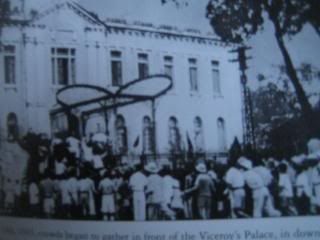
August 19, 1945: A larger crowd was organized by Viet Minh to publicly declared Viet Minh plundered the Tran Trong Kim government.
In Central, all areas protested with arms. August 18, 1945, Bao Dai ordered the “ Hội Đồng Cứu Nguy” the country in danger, called all the parties ready to fight.
August 21, 1945: Bao Dai was forced to give up his position.
August 24, 1945: Bao Dai agreed and became the normal citizen.
August 24, 1945: Bao Dai agreed and became the normal citizen.
In the mean time, the South had number of organizations: Mat Tran Quoc Gia Thong Nhat, Viet Nam Doc Lap Ho Van Nga, Thanh Nien Tien Phong Pham Ngoc Thach, Cao Dai, Hoa Hao, Viet Nam Phuc Quoc Hoi Tran Van An, the Intellectuals Groups, the Trosky communist group Ta Thu Thau.
August 21, 1945: Viet Minh leaflets were dropped all over Saigon.
September 2, 1945: Ho Chi Minh declared “Vietnam Independent” (second time after Bao Dai in 3/1945) at Ha Noi. A provisional government was formed composing of both communists and nationalists.
The United States, France, Britain, Vietnam, and others after the World War II
Why did the French return to Vietnam?
U S president F. Roosevelt, before his death in April 12, 1945, had the policy about colonists to return the colonies to the nations that included Indochina (Viet Mien Lao). However, just before the complete finish of WW II, the situation changed the plan concerning the U S’s decision.
The conference in San Francisco from 24/4/1945 – 26/6/1945 (Pentagon Papers, Gravel Edition, Background to the Crisis 1940-1950, Boston: Beacon Press, 1971) gathered 50 countries. In a report from Secretary of State (US) Mr. Stettinius witnessed that Secretary Bidault (under de Gaulle) felt released when the U S in a way letting the return of French.
Potsdam between July 17 -August 2, 1945: Troops of Tuong Gioi Thach took care the defeated Japanese at the North, and the South was for the British.
Potsdam followed the usual pattern of Anglo-American wrangling in the weeks beforehand, combined with some obvious blackmail by General de Gaulle. The French leader told the Americans “if you are against us in Indochina, this would cause terrific disappointment in France and might drive France into communist hands. We do not want to become communist”, de Gaulle warned, “but I hope you do not put us into it.”
Especially, Ho and his colleagues finally recognized that the United States, far from being neutral, was actively assisting France by shipping its troops back to Indochina with American transport and equipment…The Cold War had come to Indochina. The noisy flaunting of US jeeps, lorries and armoured cars in Saigon by the French was an unwelcome reminder to all Vietnamese that they would be looking to the far west in vain. It was also a warning to the Viet Minh of things to come.
(page 55, 122; Britain in Vietnam, Prelude to disaster, 1945-1946, by Peter Neville)
(page 55, 122; Britain in Vietnam, Prelude to disaster, 1945-1946, by Peter Neville)
Before Sept 2, 1945, Ho Chi Minh and his colleagues including Vo Nguyen Giap, Nguyen Huu Dang…had several attempts to invite U S team of OSS (Office of Strategic Services) headed by Archimedes Patti to be with him on that day as a way of recognition of his government.
 Note under picture (“Why Vietnam” by Archimedes Patti, page 30): 26 August 1945, Hanoi, Ho Chi Minh sends an official delegation headed by Vo Nguyen Giap to welcome the American OSS mission to Hanoi. While the band plays the American National Anthem, Giap and his delegation join the author and the OSS team in saluting the American flag.
Note under picture (“Why Vietnam” by Archimedes Patti, page 30): 26 August 1945, Hanoi, Ho Chi Minh sends an official delegation headed by Vo Nguyen Giap to welcome the American OSS mission to Hanoi. While the band plays the American National Anthem, Giap and his delegation join the author and the OSS team in saluting the American flag.
August 30, 1945: Anti-French demonstration was organized by Viet Minh (to get sympathy from the US, perhaps?)
On September 2, 1945, only 4 members of OSS were at the meeting. There were American helicopters for observation, signs of English (The Doc Lap), and few red flags in the crowd.
September 6, 1945: Pham Quynh, an educator, was executed by Viet Minh. Mr Pham was blamed for being sided with the French.
Sainteny, a major, representative of France arrived at Hanoi on August 22, 1945 by US military plane. After US refused helping, Ho Chi Minh began “night meetings ” with socialist Sainteny. According to Patti: from mid-November to March 1946, copies of several telegrams and letters from Ho Chi Minh to the President, the Secretary of State, the Chairman of the Senate Committee on Foreign Relations, and the United Nations reached my desk…on the basis of the principle on the humanitarian grounds. Those requests were ignored.
March 06, 1946: March 6, 1946 accord between France and Ho Chi Minh was signed by Sainteny and Ho. The France at this time was under control of communist and socialist congress majority. 15,000 troops arrived to Hai Phong then toward Ha Noi. Heavy fights between Quoc Dan Dang ,the nationalists, and French. Viet Minh were hiding. By this accord, France recognized the government Viet Nam Dan Chu Cong Hoa of Ho Chi Minh which happened at the ceremony in Ha Noi on March 7, 1946. Other important fact in the accord was the unification of Three Ky that made Admiral d’Argenlieu (Indochina) very upset. The unification would mean Vietnam from North to South become communist state.
Obviously, people in Hanoi saw the acts of Ho Chi Minh. A poem had been circulated around ironically mocking Ho Chi Minh for welcoming French back in Vietnam: Mộ Quỳnh cỏ mọc còn xanh; Hỏi ai bán nước, ấy anh già Hồ! The tomb of Quynh still with green grass; Who did commit an act of treason? He is the foxy Ho! After this bad reputation, Ho wrote a few times to defend himself that Ho would never commit an act of treason (bán nước) - Hồ Chí Minh không và sẽ không bao giờ là một người bán nước. (Những Mẩu Chuyện về Đời Hoạt Động của Hồ Chủ Tịch, tác giả Trần Dân Tiên tức Hồ Chí Minh, trang 133)
March 24, 1946: Admiral Thierry d’Argenlieu welcomed Ho Chi Minh aboard the French warship Emile Bertin amidst the spectacular natural scenery of Ha Long Bay…D’Argenlieu recorded his adversary’s long history as ‘Un vieux relent d’anticolonialisme’, Moscow-trained, and chief of the Indochinese Communist Party. ( Britain in Vietnam, page 143).
At this moment in time, Ho was sure that d’Argenlieu was very much against the March 6 Accord. Per conversations, Ho’s unpleasant expression was shown clearly on films and images. Mouth pieces and propaganda explained Ho was threatened by d’Argenlieu.
April 1946: A meeting request by d’Argenlieu took place in the Lycée Yersin in Dalat. Giap was at this event. Giap left for Hanoi convinced that war was inevitable (Britain in Vietnam, page 145).
May 19, 1946: Ho Chi Minh met d’Argenlieu in Hanoi this time before the forthcoming at Fontainebleau meeting. People were on street greeting the Admiral. From this day, May 19 has been the birth of Ho Chi Minh.
May 28, 1946: Pham Van Dong led a delegation to Fontainebleau conference, near Paris. Nguyen Tuong Tam, a nationalist, was in the list but ran away after realizing he was duped. About the same time Ho and his team also flew to France in different path.
The conference began on July 6, 1946 and ended September 9, 1946. Pham Van Dong was merely unsuccessful that in Viet Su 12ab, publisher Truong Thi, 1974, noted that d’Argenlieu and Dong had very heated discussion.
June 2, 1946: France had election. Felix Gouin was defeated whose communist and socialist- led coalition had helped Ho Chi Minh with the March 6 Accord. The political development in France began to take effect dramatically that Ho had smelled months before when meeting with d’Argenlieu. The Conservative under George Bidault controlled the congress since.
Being busy with election, Sainteny was ordered to guard Ho Chi Minh while members of government were not available. In Sainteny’s memoirs, he noted that Ho Chi Minh appeared exceptionally nervous on the occasion.
Ho Chi Minh and his team had time to walk on the beach.
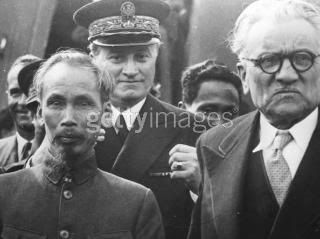 Ho Chi Minh was greeted by group of communists and socialists led by Marius Moutet, Minister of Foreign Relation. ( Getty Images)
Ho Chi Minh was greeted by group of communists and socialists led by Marius Moutet, Minister of Foreign Relation. ( Getty Images) On July 14, 1946, France Independent Day, Ho was moved from front row to few rows after by Prime Minister Bidault’s order. Perhaps, Bidault obviously let the world know he opposed international communist Ho Chi Minh shortly before the real war happened. (Getty Images)
On July 14, 1946, France Independent Day, Ho was moved from front row to few rows after by Prime Minister Bidault’s order. Perhaps, Bidault obviously let the world know he opposed international communist Ho Chi Minh shortly before the real war happened. (Getty Images)  There was time for Ho and Sainteny having pleasure with foods and drinks
There was time for Ho and Sainteny having pleasure with foods and drinks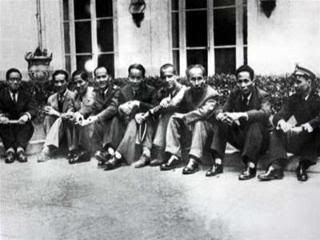
Before returning to Vietnam, two groups, led by Pham Van Dong and Ho Chi Minh, met and took a picture.
The night before Ho was to return to Vietnam, Salan (French general) said to him- and Ho must have known it was true- “We are going to fight each other, and it will be very difficult.” Indeed, Ho had told Sainteny and Marius Moutet, “If we have to fight, we will fight…You will kill ten of us and we will kill one of you, but you will be the ones who grow tired.” (Ho Chi Minh, A Biography, by Pierre Brocheux, translated by Claire Duiker, 2007)
September 14, 1946: Ho Chi Minh came to Marius Moutet’s house after midnight for his signature with an “accord” on hand that later called “Modus Vivendi September 14, 1946″ . Moutet had tried much to help Ho Chi Minh during 4 months Ho in France. This “accord” of course had no value, moreover, this showed more Ho’s decision of welcoming the French back to Vietnam for their advantages, not the Vietnamese people. In reality, this “accord” as described later, in history books for students, that Ho was so “creative” dragging on with time in an impasse situation.

Ho Chi Minh’s French hosts finally got rid of him on 18 September when he sailed for Vietnam on the French cruiser the Durmont d’Urville, having refused a French offer of an aeroplane. On reaching Marseilles, Ho was greeted with shouts of “traitor” by some Vietnamese students. Why taking cruise? The most likely explanation, perhaps, is the one put forward by Jean Sainteny that Ho feared for his life if he went by air (he remember, perhaps, the fate of Vinh San in December 1945). (Britain in Vietnam, page 156)
Author of Britain in Vietnam also stated the French communist plot. De Gaulle and Vinh San had agreed on December 1945 that Vinh San would return to Vietnam beginning of March 1946 with condition that “two flags would fly side by side” in Hanoi, Hue, Saigon, and with further meeting. But as it turned out, these plans were rendered null and void, first by Vinh San’s tragic death in an air crash on 24 December shortly after he met de Gaulle…Vinh San’s body was returned to Vietnam in 1987 , it was received with full military honours by the communist premier Pham Van Dong (Britain in Vietnam, page 117).
In the cruise, September 22, 1946, Ho Chi Minh wrote a letter to his female comrade he called “So Diet”. Ho pledged for her support by any mean to have French return to Vietnam and recognize his government. This was the last attempt hopelessly. The whole letter is in “Ho Chi Minh va Mot Nua Nhan Loai” written by Tran Khue.
October 21, 1946: Ho Chi Minh arrived in Vietnam this day and greeted by his close comrades. Soon after they were ready for the war that had ignited months before when in April 1946 at conference in Dalat, Vo Nguyen Giap convinced that war was inevitable.

While being attacked by the French, Ho Chi Minh changed tactics. Not entreating the French like before, Ho announced that the French coming back Vietnam for its second colonialism. Unfortunately, as Ho estimated, Vietnamese population at that time was 95% illiterate. Many including nationalists from the South followed his way to fight the French without realizing the threat of communism that they had been involved blindly.
President Richard Nixon, in his book “No More Vietnams“, he stated (page 31):We should have intervened alone if necessary to help the French because they were the strongest regional power fighting Communist aggression. If we had saved Dien Bien Phu, the French still probably would have withdrawn and finally given their colonies independence, as we had urged for so long, but they would have done so in a deliberate and responsible manner than in a headlong rush for the door .
Pierre Brocheux also noted that France had no intension of having Vietnam its colony at this time. Ho wrote a book which reveals his thoughts and feelings about France and French people. He wrote about where he went, what he did, and whom he met in 1946. But was he ignorant that he failed to mention in 1946, French also left Lebanon and Syria , giving back the independence for those two nations. Obviously, Ho wanted the Vietnamese to digest his propaganda that France still was in colonial policy in Vietnam.
Moreover, for the average Americans, president Nixon had to express contemptuously that an obsessive fear of associating with European colonial powers blinded successive American administrations to a very simple fact: Communism, not colonialism, was the principal cause of the war in Indochina. (No More Vietnams, page 31).
This article hopefully is for those who are still confused about the role of Ho Chi Minh in the critical period 1945- 1946, because of the propaganda and conflicts in history. As shown above, Ho had never been at a time against the France for a Vietnam independent, instead, he, a “saint communist”, would always follow his big communist brothers’ guidance to spread red blood (symbol of red flag) all over Vietnam and then the world. Because of his ambition of becoming a Stalin of Vietnam, Ho is a source of the war 1946-1954, and the bigger war 1954-1975 that killed millions of people.
But Su
Sources: Why Vietnam, Archimedes L.A. Patti, 1980; Ho Chi Minh- A Biography, Pierre Brocheux, 2007; Ho Chi Minh, William Duiker, 2000; No More Vietnams, Richard Nixon, 1986; Britain in Vietnam – Prelude to disaster, 1945-46, Peter Neville, 2007; Sử Địa 12ab, Ban Giaó Sư Sử Địa, nhà xb Trường Thi, Saigon, 1974; Những Mẩu Chuyện về Đời Hoạt Động của Hồ Chủ Tịch, Trần Dân Tiên, 1975; Pentagon Papers, Gravel Edition, Background to the Crisis 1940-1950, Boston: Beacon Press, 1971.

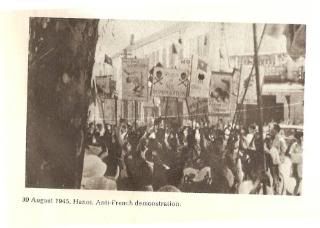
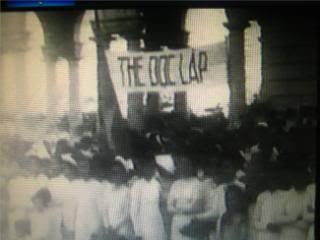
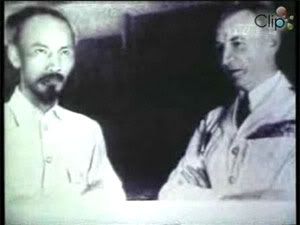
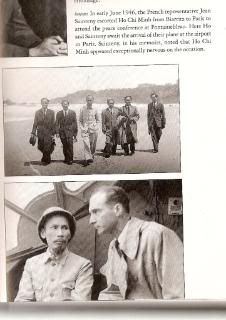
No comments:
Post a Comment